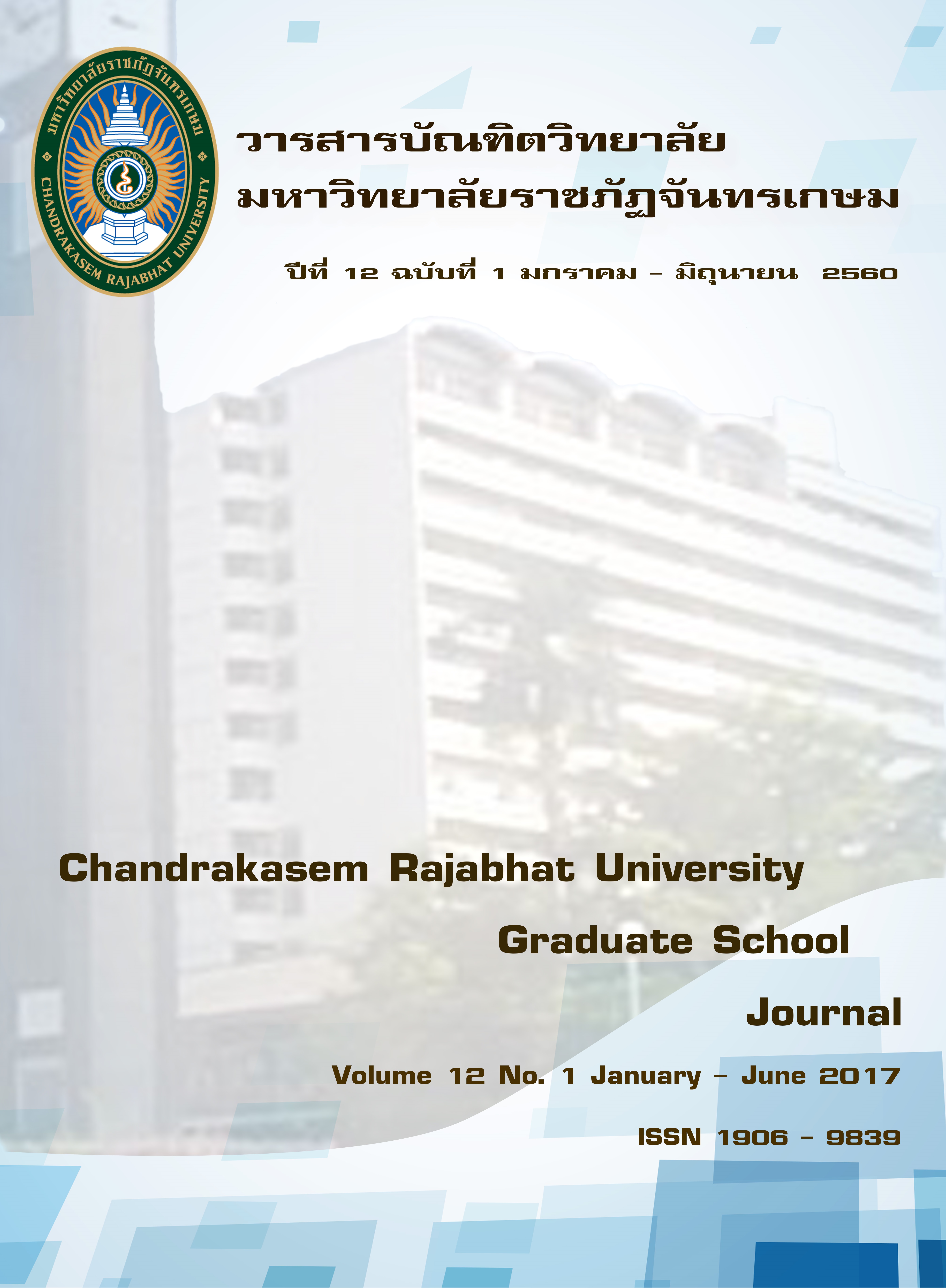การวัดและประเมินผลการเรียนรู้ด้วยการให้คะแนนแบบรูบริค : Scoring Rubrics
Main Article Content
บทคัดย่อ
การวัดและประเมินผลการเรียนรู้ตามแนวปฏิรูปการศึกษาเป็นการวัดและประเมินผลที่เน้นผู้เรียนเป็นสำคัญ มีจุดมุ่งหมายที่สำคัญคือ ส่งเสริมให้ผู้เรียนเกิดการพัฒนาและเรียนรู้ก้าวหน้าสูงสุด เป็นคนดีคนเก่งและมีความสุขได้เต็มตามศักยภาพ การจัดการเรียนรู้จึงเป็นไปเพื่อให้ผู้เรียนได้สร้างองค์ความรู้ด้วยตนเอง เน้นการลงมือปฏิบัติ (Action Learning) ไปพร้อมๆ กับการวัดและประเมินผลการเรียนรู้ ด้วยการประเมินจากสภาพจริง (Authentic assessment) ซึ่งจะประเมินด้วยวิธีการและเกณฑ์ที่หลากหลายสอดคล้องกับพฤติกรรมหรือทักษะการปฏิบัติของผู้เรียนที่มีความซับซ้อนและต่อเนื่อง ป้จจุบันมีแนวคิดในการประเมินที่มีการกำหนดเกณฑPการให้คะแนนและคำอธิบายคุณลักษณะหรือคุณภาพในการปฏิบัติงานของผู้เรียนออกเป็นระดับ ตั้งแต่ระดับสูงหรือดีมากจนถึงระดับต่ำหรือต้องปรับปรุง เกณฑ์การให้คะแนนประเภทนี้คือ “การให้คะแนนแบบรูบริค” (Scoring rubrics) ซึ่งเป็นเครื่องมือที่ใช;ในการประเมินผู้เรียนประกอบด้วยชุดของเกณฑ์หรือคำอธิบายที่มีความเฉพาะเจาะจงและมีความต่อเนื่องกัน สำหรับวิเคราะห์ผลงานหรือกระบวนการทำงานของผู้เรียน โดยจะกำหนดคำอธิบาย/รายละเอียดของเกณฑ์ไว้อย่างชัดเจนเหมาะสำหรับการประเมินทักษะที่มีรายละเอียดค่อนข่างมากหรือซับซ้อน แบ่งออกเป็น 2 ประเภทที่สำคัญ คือ (1) การให้คะแนนแบบองคPรวม (Holistic scoring rubrics) และ (2) การให้คะแนนแบบแยกองค์ประกอบ (Analytic scoring rubrics) ประชนPของการให้คะแนนแบบรูบริคนั้น ก็เพื่อเป็นแนวทางให้ผู้สอนประเมินทักษะการปฏิบัติของผู้เรียนได้อย่างรวดเร็วและครอบคลุม โปร่งใสและชัดเจน ให้ข;อมูลย;อนกลับแกjผู้เรียนทั้งจุดเด่นที่ควรพัฒนาและข้อบกพร่องที่ควรปรับปรุง ตลอดจนส่งเสริมและสนับสนุนการจัดการเรียนการสอนของครู อันจะนำไปสู่การบรรลุเป้าหมายของการจัดการศึกษา
Article Details
เอกสารอ้างอิง
2. โชติกา ภาษีผล. (2559). การวัดและประเมินผลการเรียนรู้. กรุงเทพ : โรงพิมพ์แห่งจุฬาลงกรณ์มหาวิทยาลัย.
3. รัตนาภรณ์ ทรงนภาวุฒิกุล. (2559). เอกสารประกอบการสอนรายวิชา GSDT5105 การวัดและประเมินผลการเรียนรู้ หลักสูตรประกาศนียบัตรบัณฑิตสาขาวิชาชีพครู. คณะศึกษาศาสตร์.มหาวิทยาลัยราชภัฏจันทรเกษม.
4. วัฒนาพร ระงับทุกข์. (2541). การจัดการเรียนการสอนที่แน้นผู้เรียนเป็นศูนย์กลาง.(พิมพ์ครั้งที่ 1) บริษัท ต้นอ้อ 1999 จำกัด.
5. วิจารณ์ พานิช. (2556). การสร้างการเรียนรู้สู่ศตวรรษที่ 21. มูลนิธิสยามกัมมาจล กรุงเทพ : ส.เจริญการพิมพ์
6. Barbara M. Moskal. (2000). Practical Assessment, Research & Evaluation. A peer-reviewed electronic journal. Volume 7, Number 3, March, 2000.
8. Brookhart, S. M. (1999). The Art and Science of Classroom Assessment: The Missing Part of Pedagogy. ASHEERIC Higher Education Report (Vol. 27, No.1). Washington, DC: The George Washington University, Graduate School of Education and Human Development.
9. Brookhart, S. M. (2013). How to Create and Use Rubrics for Formative Assessment and Grading. Alexandria, VA: ASCD, 2013.
10. Griffin, Merilee. (2010). What is a Rubric? Assessing Outcomes and Improving Achievement: Tips and Tools for Using Rubrics. Ed. Terrel L. Rhodes.
11 Washington, DC: Association of American Colleges and Universities, 2010.
12. Nitko, A. J., & Nitko, A. J. (1996). Educational assessment of students.Englewood Cliffs, N.J: Merrill.
13. Mertler, Craig A. (2001). Designing Scoring Rubrics for Your Classroom. Bowling Green State University Bowling Green, OH 43403
14. Mary J. Allen. (2008). Developing and Using Rubrics for Assessing, Grading, and Improving Student
Learning. SACS-COC Summer Institute.
15. Merriam-Webster dictionary (online : https://www. merriam-webster.com).


